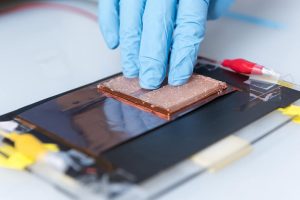Researchers from Sharif University of Technology, Amirkabir University of Technology, the University of Tehran, and University College Dublin have investigated the design of triboelectric nanogenerators (TENGs) with antibacterial functionality.
According to the Report, Triboelectric nanogenerators, which harvest energy from physical movements, have attracted significant attention across various industries in recent decades. This technology shows strong potential in applications such as wearable electronics and medical devices. However, one of the main challenges in their use is direct skin contact and the associated risk of bacterial growth. For this reason, studying the interactions between electrical charges, host materials, and bacterial activity is essential.
In a comprehensive study, the research team examined how charge polarity and host materials influence antibacterial performance. The study focused on two negatively charged bacterial models: Escherichia coli (E. coli) and Staphylococcus aureus (S. aureus).
How does electrical charge control bacterial growth?
The findings revealed that positively charged host materials (such as aluminum or graphene oxide) significantly inhibited bacterial growth. This effect is attributed to electrostatic interactions between bacteria and host materials, which lead to electron withdrawal from the bacterial respiratory chain. As a result, bacterial energy metabolism is disrupted, halting their growth—an effect particularly evident with aluminum and graphene oxide.
Interestingly, when negatively charged materials were involved, the antibacterial behavior varied considerably. Aluminum exhibited minimal antibacterial activity, while graphene oxide showed a strong effect. This was linked to the production of reactive oxygen species (ROS) on the graphene oxide surface, which rapidly suppressed bacterial growth.
Does the host material influence antibacterial effects?
Yes. The results demonstrated that the choice of host material has a major impact on the antibacterial performance of triboelectric nanogenerators. Since graphene oxide can generate ROS and effectively inhibit bacterial growth, it stands out as an excellent candidate for use in antibacterial wearable devices.
In comparison, aluminum limited bacterial activity only through electron absorption, while graphene oxide, by producing ROS and affecting bacterial biochemical processes more extensively, displayed much stronger antibacterial properties. These findings indicate that selecting the right host material can greatly enhance the antibacterial functionality of triboelectric nanogenerators.
Implications for wearable device design
The study provides valuable insights for the future design of triboelectric nanogenerators in wearable and biomedical technologies. Leveraging these findings, devices can be developed that not only harvest body movement to generate energy but also actively prevent bacterial growth. This dual functionality would be especially beneficial in healthcare settings and scenarios where controlling bacterial transmission is critical.
The joint Iranian–Irish study shows that triboelectric nanogenerators, particularly when combined with materials such as graphene oxide, can achieve effective antibacterial performance. By controlling electrical charges and optimizing material selection, this technology can become a powerful tool in combating bacterial infections. These advances mark an important step toward next-generation wearable and medical devices that integrate advanced hygienic features alongside their conventional functions.


